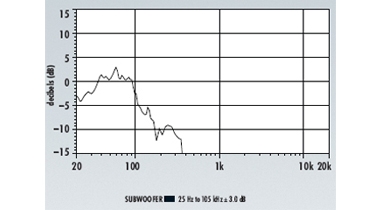BG Radia BGX 4850 Page 3

Frequency Response 25 Hz to 105 kHz ±3.0 dB
Bass limits (lowest frequency and maximum SPL with limit of 10% distortion at 2 meters in a large room): 35.5 Hz at 81.5 dB 111.3-dB average SPL from 40 Hz to 80 Hz 122.8-dB maximum SPL at 72 Hz Bandwidth uniformity 90%
I measured the BGX-4850 with all four subwoofers connected, because it's sold as a four-subwoofer package. Its close-miked performance is excellent, producing a nearly flat response from 19 to 105 Hz. This is the result of internal equalization in the amplifier. Just out of curiosity, I connected one sub module to a conventional amplifier and close-miked one of the enclosures. This revealed that the "native" response (to borrow a term from the video world) of each 4-inch woofer in its small enclosure peaks at 110 Hz and declines at 12 dB/octave below that. By combining the response of 48 such driver/enclosure combos and using equalization to smash down the big peak at 110 Hz, BG is able to achieve a fairly flat response across the entire bass spectrum.
However, the BGX-4850's distortion profile is like none I've encountered. Usable output (below 10% distortion) between 40 and 80 Hz is extraordinarily high. However, below 35 Hz, things got weird. At some frequencies, distortion ran above 10% at all levels. At other frequencies it dropped below (although not much below) 10%. For example, at 25 Hz, distortion never dropped below 15%, but distortion dropped as low as 8% at 22.5 Hz (where the BGX-4850 puts out 98.3 dB at 10% THD). Normally, once you drop below a certain frequency - the one we cite as the bass limit - distortion always increases as frequency decreases.
I thought this anomaly might be caused by an unusual interaction of the four-subwoofer configuration in my room. My measurements are calibrated to the acoustics of my listening room, but that calibration was performed with a single subwoofer, not four. I tried repositioning the subwoofers and moving my microphone, but was unable to better my original results.













































